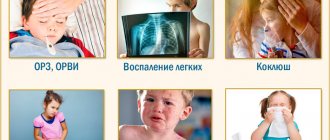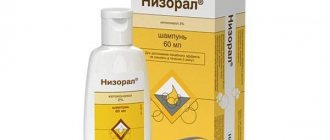A child has a sore throat: what and how should parents do in this case?
consultation with a pediatrician at a medical center Sore throat is one of the common reasons for outpatient and emergency visits by parents of children to doctors for help. Upper respiratory tract infections are very common in both children and adults and have significant economic consequences associated with the frequent prescribing of antibiotics by physicians, even when the causative agent is not bacteria. About a quarter of children suffering from tonsillitis also suffer from bacterial pharyngitis. Identification and adequate antibiotic treatment of group A streptococcal sore throat is important for the primary prevention of acute rheumatic fever, which occurs in 3% of cases. Therefore, in any case, if you have a sore throat, you need to show your child to a doctor to rule out diseases that are dangerous to health and life.
Signs of complications with a sore throat
If your baby begins to show the following symptoms, he may have become a victim of complications from a sore throat:
- severe sore throat;
- sore throat (redness);
- painful to swallow;
- it hurts to talk;
- severe burning sensation;
- painful irritation in the throat.
A severe sore throat can affect the baby's well-being. If these symptoms do not go away after a few days, or if your sore throat gets worse, you should see a doctor.
How does a sore throat manifest?
The main symptom of a sore throat is pain, both at rest and when swallowing or talking. A sore throat is the primary symptom of pharyngitis. The terms "angina" and "pharyngitis or pharyngotonsillitis" are often used interchangeably. Pharyngitis refers to objective signs of inflammation of the pharynx: swelling, exudation, ulceration or obvious erythema. Redness of the throat may occur as part of a general redness of all mucous membranes of the upper respiratory tract in young patients with fever. The diagnosis of pharyngitis is justified only when the pharynx is objectively redder than the rest of the mucous membranes.
Treatment of red throat in infants
Every parent needs to know that a child’s sore throat is not a diagnosis. This is a symptom of many different diseases. When you discover a red throat in an infant, treatment should be prescribed by a pediatrician in accordance with the possible cause of inflammation:
- viral infection;
- tonsillitis;
- colds;
- presence of allergen;
- accompanying sign of teething.
Depending on the diagnosis, the doctor will select the most appropriate treatment tactics, using medications that are preferable for infants. Self-medication is unacceptable. It is dangerous for a small child to develop serious complications.
What could be the causes of a sore throat?
Most often, sore throats are caused by viruses. Less commonly, sore throats occur due to bacterial infections. Viral pathogens such as corona virus, rhinovirus, adenovirus, influenza and parainfluenza are the most common and usually present as a cold. Other viral infections that may present with a sore throat are the Epstein-Barr virus and HIV, which lead to the development of a sore throat early in the disease.
Recurrent tonsillitis may occur due to cytomegalovirus or fungal infections in young patients with immunodeficiency.
Among bacterial infections, group A beta-hemolytic streptococcus (GABHS) is the most common cause of bacterial sore throat. It accounts for 15–36% of cases of acute pharyngitis in children in developed industrial countries. Other pathogens may include streptococci types C and G.
Rarer causes of sore throat include infections with Staphylococcus aureus, Mycoplasma, Chlamydia pneumoniae, Moraxella catarrhalis and Yersinia.
Fusobacterium necrophorum infection is an uncommon infection that begins with fever and sore throat and may subsequently develop into Lemierre's syndrome, which is characterized by blood poisoning, thrombosis of the internal jugular vein, and at least one metastatic site of infection.
Another group of causes of sore throat in children are peritonsillar, retropharyngeal and lateral pharyngeal abscesses, which arise due to the spread of infection from local sources, for example, bacterial tonsillitis. Along with fever and sore throat, these cases may present other symptoms such as painful swallowing, drooling, trismus, visible swelling under the lower jaw and deviation of the uvula away from the source of inflammation.
Allergies can also be the cause of a sore throat, especially when it is complicated by nasal bleeding. Irritants such as dust, tobacco and silt stove smoke, and chemical air pollutants can lead to chronic sore throat.
Talking for a long time in a raised voice or shouting for a long time also lead to a sore throat.
A sore throat can also occur due to damage to the larynx by stomach acid due to gastroesophageal reflux disease (GERD).
Home diagnostics: a child has a sore throat.
Each of the reasons has its own characteristic signs, by which you can roughly guess the diagnosis while you wait for the doctor. All throat diseases have both common and fundamentally different symptoms.
For example, a sore throat is observed with both pharyngitis and laryngitis. But in the first case, when swallowing, the pain “radiates” to the ear, but in the second, it does not.
• Sore throat is a pain in the throat and head, body temperature up to 38 degrees inclusive, worsening sleep and appetite.
• Pharyngitis is a sore throat and pain when swallowing, which is transmitted to the ears, and a cough is possible.
• Infectious mononucleosis - pain in the head, joints, muscles, and throat when swallowing, weakness and inflammation of the lymph nodes.
• Laryngitis - dryness, burning, sore throat, and later - coughing, wheezing, hissing.
• Diphtheria of the pharynx (acute infectious disease) - severe sore throat, fever, tonsils and mucous membranes near them are covered with a yellow coating, weakness. Accurate diagnosis - only by laboratory smear!
• The common cold – long-lasting sore throat, deep red mucous membrane of the larynx, sometimes runny nose, cough, headache.
• Adenoiditis (inflammation of the adenoids) - constant sore throat, difficulty breathing, sometimes snoring during sleep, “husky” pronunciation and frequent deep sighs. Laryngeal pain from adenoiditis in infants is dangerous due to attacks of arrhythmia and tachycardia.
What signs of the disease are assessed by the doctor?
When collecting an anamnesis and examining a child, the doctor will pay attention to the following symptoms:
- Onset and duration of sore throat
- Severity of fever
- Associated cough, runny nose, conjunctivitis, headache, myalgia (muscle pain)
- Any difficulty breathing, especially snoring at night or stridor
- History of rash, diarrhea, or allergies
- Regurgitation (reflux of gastric contents into the esophagus), pain in the epigastric or retrosternal region.
- Family history of sore throat in the past 2 weeks.
- Similar complaints in the past,
- Vaccination history
When examining the throat, the doctor may reveal:
- White or gray plaques on the surface of the tonsils or pharynx that rub off easily without bleeding.
- Ulcerations
- Plaques in the form of films, characteristic of infectious mononucleosis, diphtheria and sometimes streptococcal infection. Tularemia can also be a rare cause of such plaques.
- Films of gray or black color, extending beyond the tonsils, with swallowing problems and the absence of severe fever, are characteristic of diphtheria.
- Oral thrush, which is common in newborns and infants, may have a pseudomembrane (curdled plaques), the removal of which can cause mild pinpoint bleeding.
- Convexity of the oropharynx or lateral displacement of the uvula indicates a parapharyngeal or peritonsillar abscess.
- Herpetic sore throat is characterized by painful vesicular (bubble-like) formations on the pharynx and tonsils. Herpes simplex causes painful blisters limited to the front of the mouth, which can sometimes spread to the front of the tonsils.
- Lymphadenopathy (enlarged and painful anterior and posterior cervical lymph nodes is characteristic of bacterial tonsillitis or Epstein-Barr virus infection.
- Streptococcal pharyngitis is characterized by sore throat, temperature ≥38.3°C, tonsil and pharyngeal plaque, and cervical lymphadenopathy.
- Cough, runny nose and diarrhea are more common with viral pharyngitis.
Still have questions?
Get an online consultation from leading pediatricians in St. Petersburg!
A professional and experienced pediatrician will answer your questions.
Medical care for a child without leaving home at a convenient time.
sign up for a consultation
A Skype consultation lasts 45 minutes.
Additional research for sore throat
The main problem when diagnosing a sore throat is not to miss the dangerous diagnoses of diphtheria and GABHS sore throat. To do this, a throat swab is taken from the child for bacterial and culture tests, including Albert's stain for diphtheria. A provisional diagnosis of diphtheria is suggested if the smear shows typical drumstick organisms. However, definitive diagnosis requires confirmation of C. diphtherium growth in culture.
To diagnose GABHS sore throat, there are antigen rapid tests. Their action is based on the extraction of group A carbohydrate antigen from throat swab materials with nitrous acid. These rapid tests are very specific (>95%) and provide immediate results, but have variable sensitivity. Confirmation of a positive result is not required, and if negative, a culture is recommended to exclude an infection dangerous to the child. Streptococcal antibody titers are not useful for diagnosing streptococcal pharyngitis and are not generally recommended.
Other studies:
- General blood analysis
- Peripheral blood smears - for the presence of atypical lymphocytes.
- Serology of Epstein-Barr virus (IgM antibodies)
- X-ray of the soft tissues of the neck (lateral view) if a retropharyngeal abscess is suspected.
- CT scan of the neck, including the base of the skull, to look for an abscess.
Treatment for a child with a sore throat
Prescriptions must be made by a doctor based on the established diagnosis and the identified or suspected pathogen. Self-prescription of medications by parents is unacceptable. This can lead to serious consequences for the child's health.
Farnigitis caused by GABHS infection is a disease that goes away on its own. However, treatment with antibiotics in this case provides rapid relief of symptoms, prevents purulent (otitis media, sinusitis, tonsillitis) and non-purulent complications, and also reduces the possibility of transmission of infection. Antibiotics reduce the incidence of rheumatic fever by more than two-thirds.
Clinical features, epidemiological criteria, and the judgment of an experienced clinician, with or without additional testing, usually indicate the need for antibiotics. The currently used pharyngitis decision score was adapted by adding age to the four components of the original Centor score (no cough, no swollen and tender anterior cervical nodes, temperature >38°C, tonsil plaque or swelling. Each component is given 1 point. age from 3 to 14 years is also given 1 point. Children or adolescents with a score of 0 or 1 do not need antibiotic therapy. Patients with a score of 2 or 3 points should undergo microbiological diagnosis of the pathogen and receive antibiotics if the results are positive. Children with A score of 4 or higher is at high risk for streptococcal GABHS pharyngitis and should receive antibiotic therapy.
Due to cost, narrow spectrum of action, safety and effectiveness, penicillin is the drug of choice. A shorter duration of treatment increases the risk of bacteriological relapse of the disease. The unjustified use of macrolides for the treatment of GABHS pharyngitis has become the main reason for the formation of resistant strains of pathogens.










